Garden Wildlife
Garden Wildlife


Millipedes
Millipedes belong to the class Diplopoda within the arthropod subphylum Myriapoda, and have long segmented bodies with many legs. While no millipedes have a thousand legs, at least one species has 750. Most have far fewer, but it is beautiful to watch the "Mexican wave" motion of their legs as they walk. They can be confused with centipedes, which also have long segmented bodies and many pairs of legs. Millipedes have two pairs of legs per segment, whereas centipedes have just one pair, and most Millipedes have short legs and antennae. They move slowly and often remain stationary, and some can roll themselves into a ball or coil when disturbed. Centipedes are generally more active and writhe or run for cover. Millipedes have about 12,000 described species globally, making them the largest myriapod group.
Species in Britain and Ireland
There are about 65 species of millipede recorded in Britain and Ireland, including at least 10 non-native species that are usually only found in heated glasshouses. Millipedes are more variable in colour and body form than centipedes. They can be black, grey, brownish white or white. Some have a row of reddish dots down the sides of their bodies. Jennifer Owen encountered 5 species in her Leicester garden, from four families.
Some millipedes have relatively flat bodies and might be confused with centipedes, although their short antennae, two pairs of legs per body segment and slower movement should establish their identity. Others are round in section and cylindrical in appearance
Flat-bodied millipedes
Common garden species of this type are from the Orders Orders Chordeumatida and Polydesmida. The false flat-backed millipede Nanogona polydesmoides is in the first order, and the large British and Irish population is globally important, and the only other country where it is common is western France. There are several common species in the Polydesmida, including the 10mm long Brachydesmus superus which likes disturbed ground, the common flat-back Polydesmus angustus, Polydesmus coriaceus which was the commonest in Jennifer Owen's garden, and Oxidus gracilis. The last mentioned is a Japanese species introduced around the world and sometimes found in the potting compost of houseplants.
Flat-backed millipedes: Clockwise from top left: false flat-backed millipede Nanogona polydesmoides showing wave-movement of legs, Brachydesmus superus, common flat-back Polydesmus angustus and Oxidus gracilis.
Round-bodied millipedes
Other millipedes have bodies that are cylindrical in cross section. In Britain and Ireland they are found in the Orders Julida, Polyxenida and Glomerida. Familiar examples of julids include the spotted snake millipede Blaniulus guttulatus, the blunt-tailed snake millipede Cylindroiulus punctatus and the white-legged snake miliipede Tachypodoiulus niger.
Above top: Common pill millipede Glomeris marginata in walking and protective rolled-up posture. Below: for comparison the pillbug woodlice, Armadillidium species, showing remarkable convergence in these unrelated animals.
Biology
Most millipedes are scavengers that feed on dead plant material. Polyxenus lagurus is an exception as it feeds on lichen and algae on walls and sometimes tree trunks. Millipedes need damp conditions and they remain mostly hidden in dark places during the day. At night they will roam around more freely in search of food. They mostly live in leaf litter and the surface layer of the soil but some species will climb up tree trunks and walls.
Life cycle
Millipedes deposit their eggs in cavities in the soil. These hatch into small versions of the adult animal but with a reduced number of body segments. Additional segments develop as the millipede grows older. It can take two or three years for some millipedes to reach the adult stage.
Role of millipedes in gardens
Millipedes tend to be more abundant in gardens where there are accumulations of leaf litter, or where the soil has been enriched with organic matter. Millipedes feed on dead plant material and help break it down into smaller fragments and as such are valuable nutrient recyclers.
Millipedes will sometimes feed on soft young plants, such as seedlings, but they are rarely a problem. They may also enlarge damage that has been initiated by fungal decay or another animal, such as slugs. The species most frequently associated with damage to garden plants is the spotted snake millipede, Blaniulus guttulatus. This can often be found in potato tubers and strawberry fruits that had previously been damaged by slugs.
Other sources of information
Website
Website of the British Myriapod and Isopod Group
Checklist of British millipedes
Books
Blower, J.G. 1985. Synopses of the British Fauna (New Series) vol 35, Millipedes. Linnean Society
Page drafted by Andrew Halstead, reviewed by Andrew Salisbury and compiled and extended by Steve Head
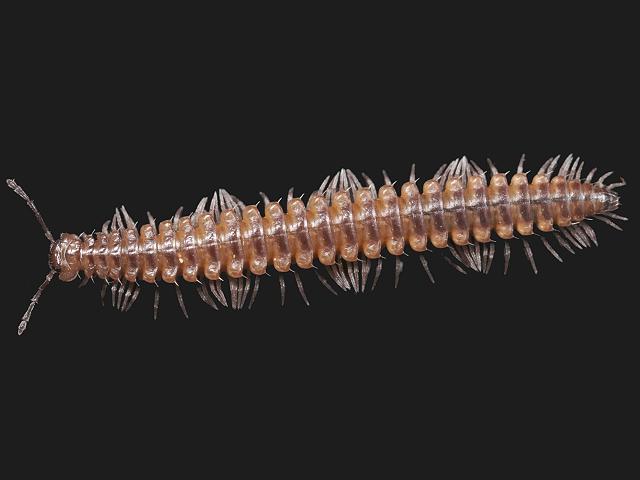
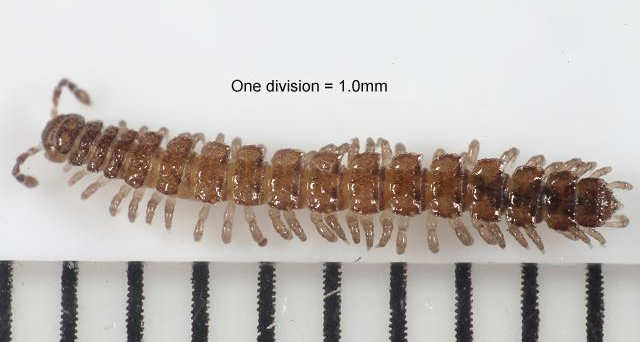
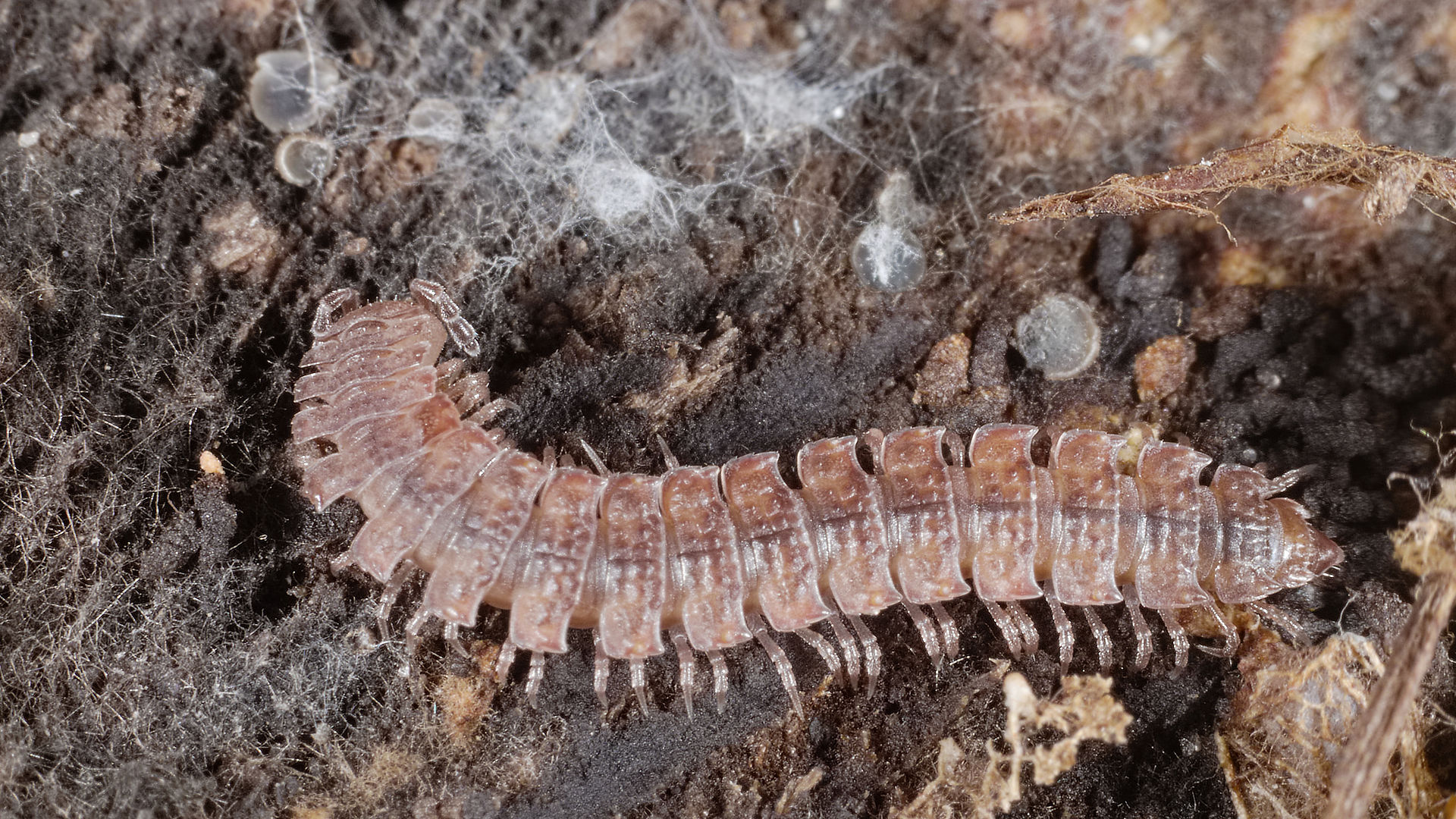
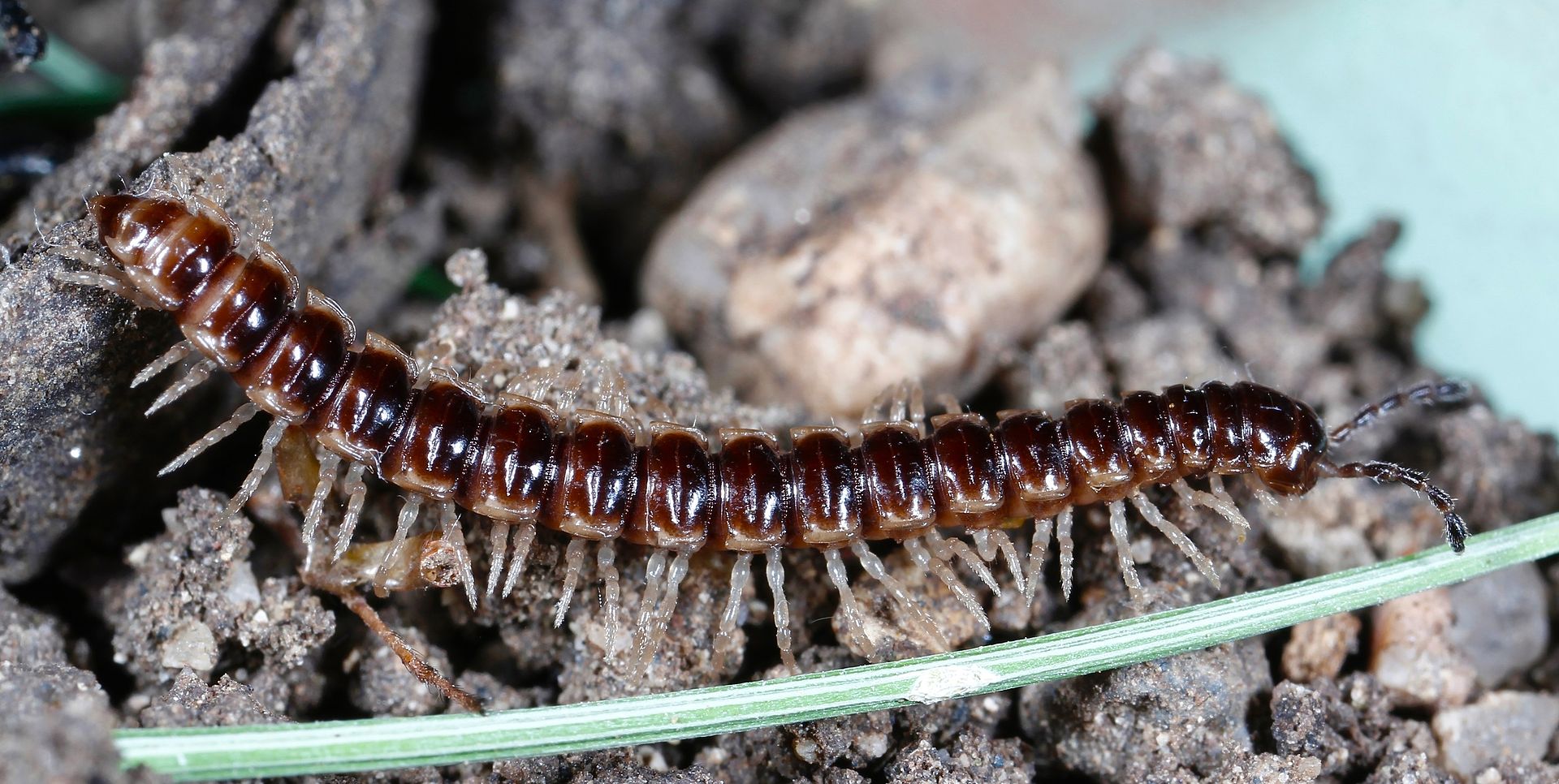
Julid millipedes. Clockwise from top left: spotted snake millipede Blaniulus guttulatus, blunt-tailed snake millipede Cylindroiulus punctatus and the white-legged snake miliipede Tachypodoiulus niger, walking and coiled in defense
In the Polyxenida we have a single species, the bristly millipede Polyxenus lagurus which is only 3mm long when fully grown and its body is covered in bundles of short bristles. It is often found with lichens and algae on which it feeds at night. It closely resembles the larvae of some hide or carpet beetles (Dermestidae). Beetle larvae have only a single pair of legs on each of the three thoracic segments, whereas millipedes have two pairs of legs on all of their body segments.
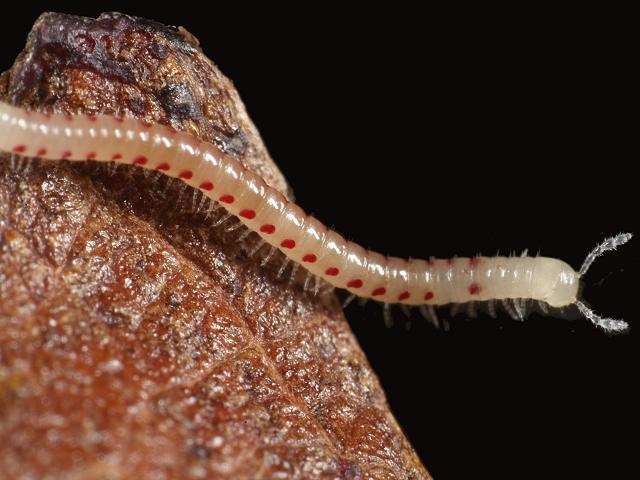
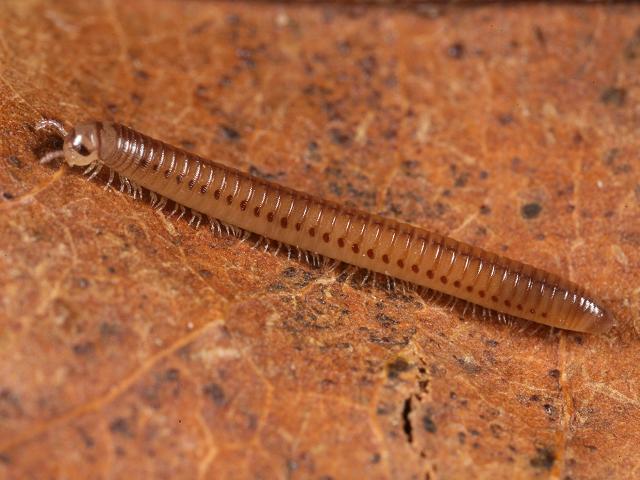
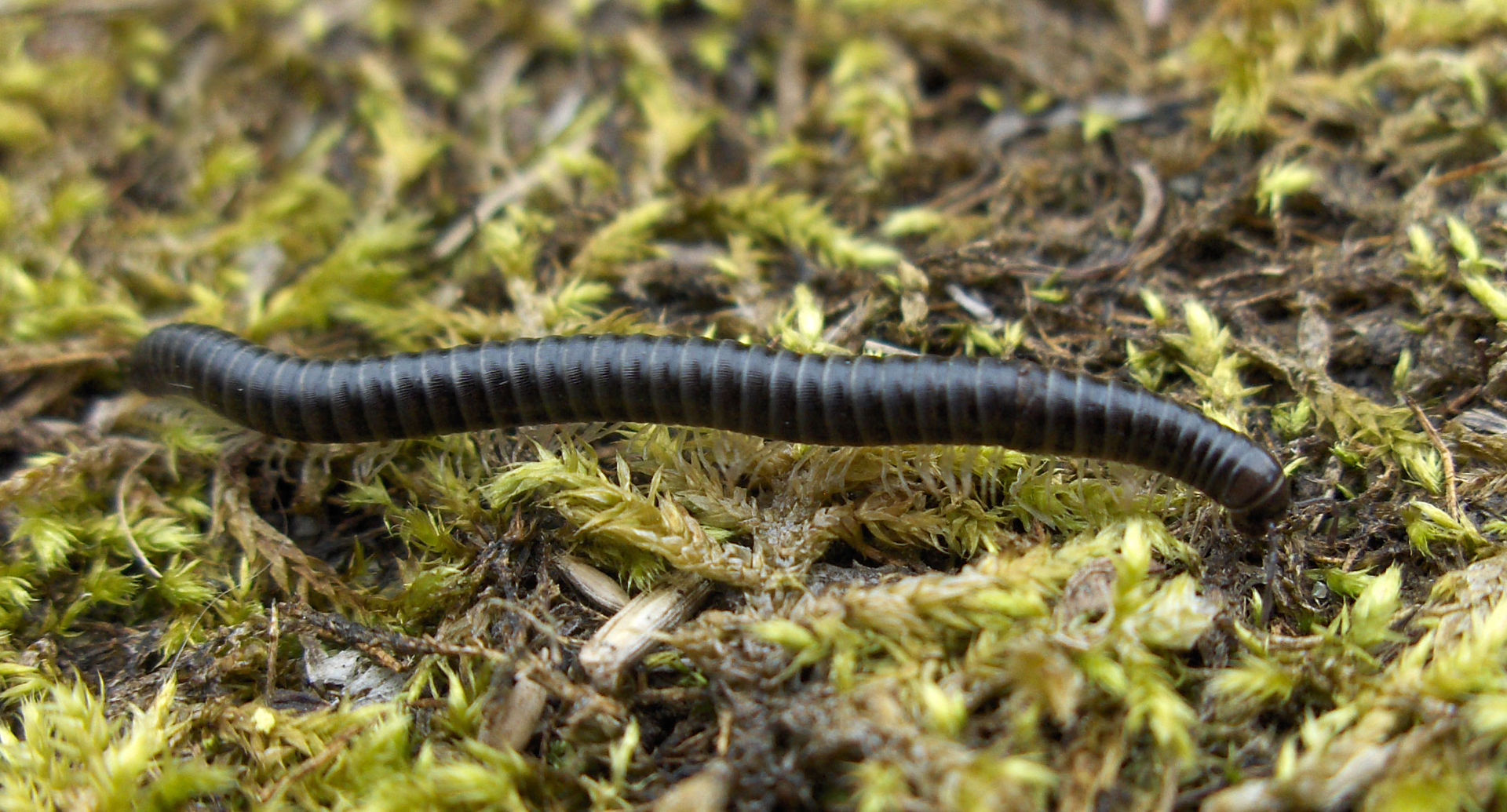
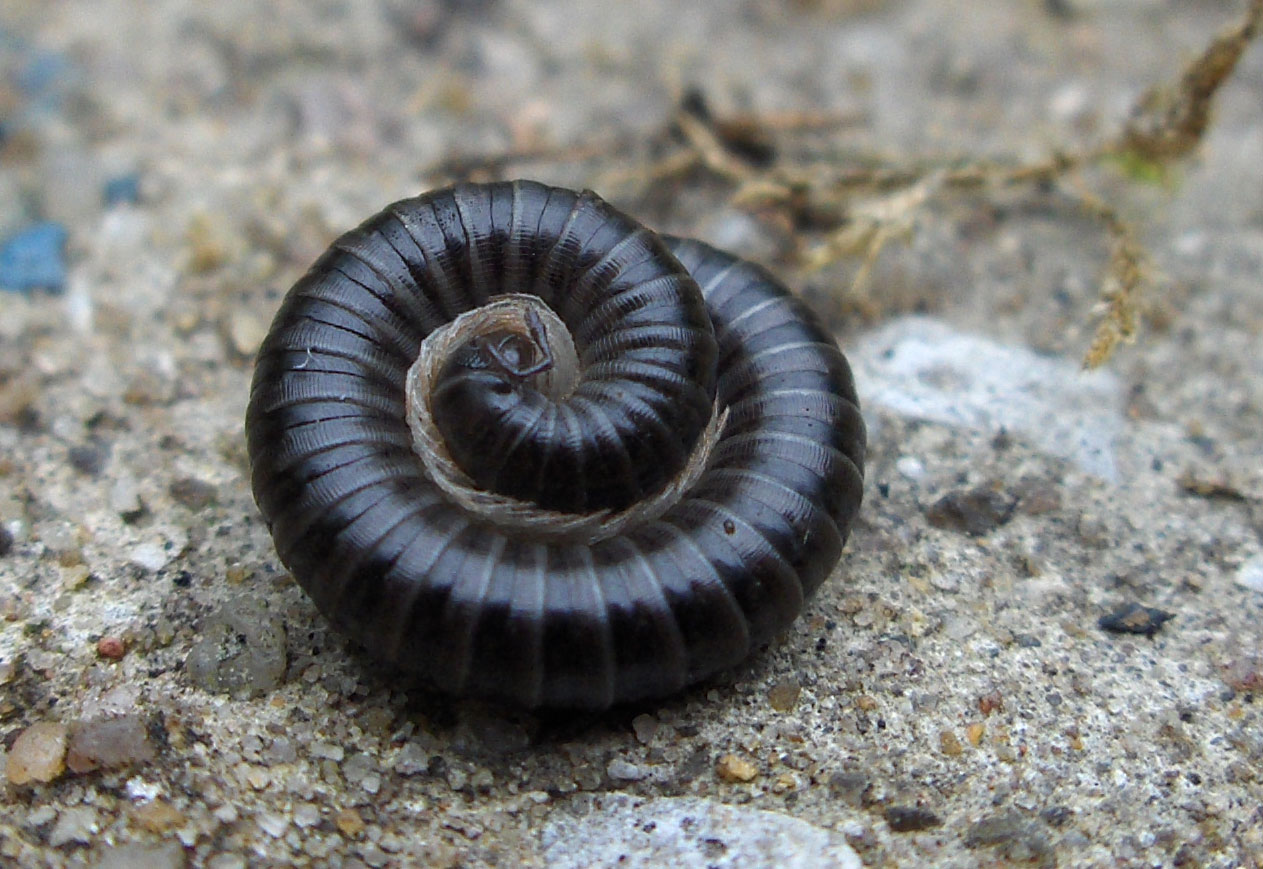
Left: Bristly millipede Polyxenus lagurus Right: carpet beetle larva for comparison.
In the pill millipede order Glomerida, we have only one common species Glomeris marginata found in England, Wales and Ireland, but not most of Scotland.. It is grey to black in colour and very short bodied, able to roll itself into a ball when threatened. It could be confused with pill woodlice, Armadillidium species, but the millipede has 17-19 pairs of legs, while woodlice have seven pairs.
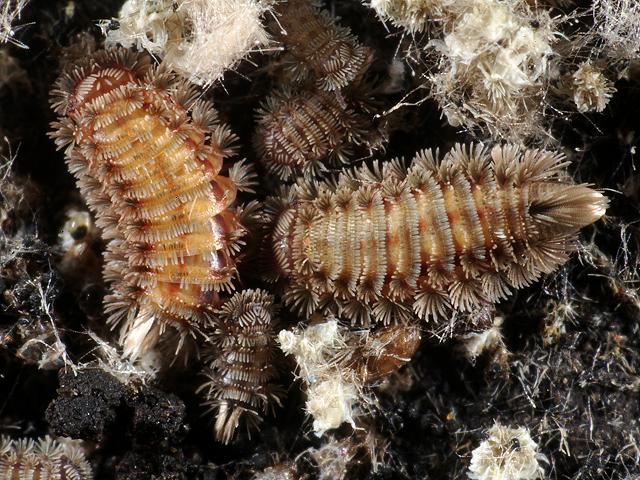
.jpg)
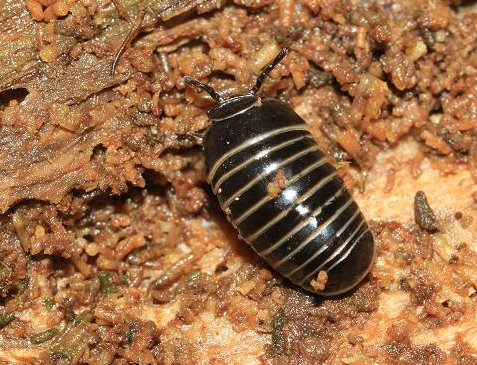
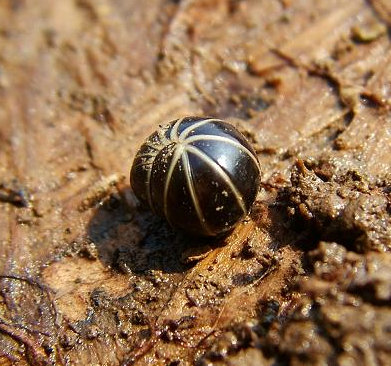
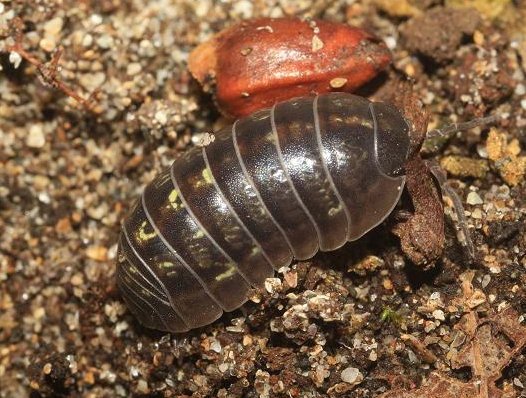

Millipedes
Millipedes belong to the class Diplopoda within the arthropod subphylum Myriapoda, and have long segmented bodies with many legs. While no millipedes have a thousand legs, at least one species has 750. Most have far fewer, but it is beautiful to watch the "Mexican wave" motion of their legs as they walk. They can be confused with centipedes, which also have long segmented bodies and many pairs of legs. Millipedes have two pairs of legs per segment, whereas centipedes have just one pair, and most Millipedes have short legs and antennae. They move slowly and often remain stationary, and some can roll themselves into a ball or coil when disturbed. Centipedes are generally more active and writhe or run for cover. Millipedes have about 12,000 described species globally, making them the largest myriapod group.
Species in Britain and Ireland
There are about 65 species of millipede recorded in Britain and Ireland, including at least 10 non-native species that are usually only found in heated glasshouses. Millipedes are more variable in colour and body form than centipedes. They can be black, grey, brownish white or white. Some have a row of reddish dots down the sides of their bodies. Jennifer Owen encountered 5 species in her Leicester garden, from four families.
Some millipedes have relatively flat bodies and might be confused with centipedes, although their short antennae, two pairs of legs per body segment and slower movement should establish their identity. Others are round in section and cylindrical in appearance
Flat-bodied millipedes
Common garden species of this type are from the Orders Orders Chordeumatida and Polydesmida. The false flat-backed millipede Nanogona polydesmoides is in the first order, and the large British and Irish population is globally important, and the only other country where it is common is western France. There are several common species in the Polydesmida, including the 10mm long Brachydesmus superus which likes disturbed ground, the common flat-back Polydesmus angustus, Polydesmus coriaceus which was the commonest in Jennifer Owen's garden, and Oxidus gracilis. The last mentioned is a Japanese species introduced around the world and sometimes found in the potting compost of houseplants.




Flat-backed millipedes: Clockwise from top left: false flat-backed millipede Nanogona polydesmoides showing wave-movement of legs, Brachydesmus superus, common flat-back Polydesmus angustus and Oxidus gracilis.
Round-bodied millipedes
Other millipedes have bodies that are cylindrical in cross section. In Britain and Ireland they are found in the Orders Julida, Polyxenida and Glomerida. Familiar examples of julids include the spotted snake millipede Blaniulus guttulatus, the blunt-tailed snake millipede Cylindroiulus punctatus and the white-legged snake miliipede Tachypodoiulus niger.




Julid millipedes. Clockwise from top left: spotted snake millipede Blaniulus guttulatus, blunt-tailed snake millipede Cylindroiulus punctatus and the white-legged snake miliipede Tachypodoiulus niger, walking and coiled in defense
In the Polyxenida we have a single species, the bristly millipede Polyxenus lagurus which is only 3mm long when fully grown and its body is covered in bundles of short bristles. It is often found with lichens and algae on which it feeds at night. It closely resembles the larvae of some hide or carpet beetles (Dermestidae). Beetle larvae have only a single pair of legs on each of the three thoracic segments, whereas millipedes have two pairs of legs on all of their body segments.

.jpg)
Left: Bristly millipede Polyxenus lagurus Right: carpet beetle larva for comparison.
In the pill millipede order Glomerida, we have only one common species Glomeris marginata found in England, Wales and Ireland, but not most of Scotland. It is grey to black in colour and very short bodied, able to roll itself into a ball when threatened. It could be confused with pill woodlice, Armadillidium species, but the millipede has 17-19 pairs of legs, while woodlice have seven pairs.


Above top: Common pill millipede Glomeris marginata in walking and protective rolled-up posture. Below: for comparison the pillbug woodlice, Armadillidium species, showing remarkable convergence in these unrelated animals.
Biology
Most millipedes are scavengers that feed on dead plant material. Polyxenus lagurus is an exception as it feeds on lichen and algae on walls and sometimes tree trunks. Millipedes need damp conditions and they remain mostly hidden in dark places during the day. At night they will roam around more freely in search of food. They mostly live in leaf litter and the surface layer of the soil but some species will climb up tree trunks and walls.
Life cycle
Millipedes deposit their eggs in cavities in the soil. These hatch into small versions of the adult animal but with a reduced number of body segments. Additional segments develop as the millipede grows older. It can take two or three years for some millipedes to reach the adult stage.
Role of millipedes in gardens
Millipedes tend to be more abundant in gardens where there are accumulations of leaf litter, or where the soil has been enriched with organic matter. Millipedes feed on dead plant material and help break it down into smaller fragments and as such are valuable nutrient recyclers.
Millipedes will sometimes feed on soft young plants, such as seedlings, but they are rarely a problem. They may also enlarge damage that has been initiated by fungal decay or another animal, such as slugs. The species most frequently associated with damage to garden plants is the spotted snake millipede, Blaniulus guttulatus. This can often be found in potato tubers and strawberry fruits that had previously been damaged by slugs.
Other sources of information
Website
Website of the British Myriapod and Isopod Group
Checklist of British millipedes
Books
Blower, J.G. 1985. Synopses of the British Fauna (New Series) vol 35, Millipedes. Linnean Society
Page drafted by Andrew Halstead, reviewed by Andrew Salisbury and compiled and extended by Steve Head












